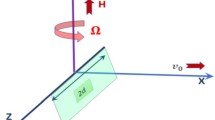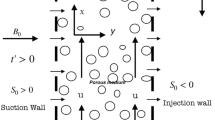Summary
The heat transfer from a liquid passing in fully established Poiseuille flow between flat parallel plates of finite thermal transmissivity is treated for an arbitrary transverse temperature distribution in the liquid at the inlet. The temperature at any point of the liquid can be represented by a series of eigenfunctions. The even eigenfunctions of this problem have been calculated in earlier work) ; in this paper the first three odd eigenfunctions are added. The results also bear on the case where the temperature of the environment at one side differs from that at the other side of the conduit. For this case the transmission coefficient is calculated. The influence of the odd terms on the thermal entry length is also discussed.
Similar content being viewed by others
Abbreviations
- x :
-
transverse distance from central flow line
- z :
-
distance in direction of flow
- θ(x, z):
-
temperature of the liquid
- θ 0 :
-
characteristic temperature difference
- v 0 :
-
mean velocity of the liquid
- D :
-
distance between the plates (characteristic length)
- ϱc :
-
heat capacity per unit volume of the liquid
- λ:
-
thermal conductivity of the liquid
- k 0 :
-
outside heat transmission coefficient of the plates
- k i :
-
apparent inside transmission coefficient of the conduit, defined by

- k t :
-
total transmission coefficient across the conduit (1/k t = 2/k 0 + 1/k i
- k :
-
total transmission coefficient of the wall (1/k = 1/k 0 + 1/α i )
- α i :
-
inside coefficient of heat transfer from liquid to wall, based on the cup-mixing mean temperature
- ϑ, ξ, ζ:
-
reduced variables, equal toϑ =θ/θ 0,ξ=x/D and ζ =z/D respectively
- Pé :
-
Péclet number (=v 0 ϱcD/λ)
- Nu 0 :
-
wall Nusselt number (=k 0 D/λ), equal toNu′ in previous work)
References
Prins, J. A., J. Mulder and J. Schenk, Appl. sci. Res.A 2 (1950) 431.
Does de Bye, J. A. W. van der and J. Schenk, Appl. sci. Res.A 3 (1952) 308.
Berry, V.J., Appl. sci. Res.A 4 (1954) 61.
Schenk, J., Appl. sci. Res.A 4 (1954) 222.
Lauwerier, H. A., Appl. sci. Res.A 2 (1950) 184.
Вяэовов, B. B., J. Techn. Phys. USSR10 (1940) 1519. See also T. K. Sherwood and R. L. Pigf ord, “Absorption and extraction”, p. 262ff, New York 1952.
Vogelpohi, G., VDI-Forschungsheft 425 (1949). See also B. Dizioğlu, Rev. Fac. Sci. Univ. IstanbulA17 (1952) 159 and 259.
Brinkman, H. C., Appl. sci. Res.A2 (1950) 120.
Author information
Authors and Affiliations
Rights and permissions
About this article
Cite this article
Schenk, J., Beckers, H.L. Heat transfer in laminar flow between parallel plates. Appl. sci. Res. 4, 405–413 (1954). https://doi.org/10.1007/BF03185252
Received:
Issue Date:
DOI: https://doi.org/10.1007/BF03185252





